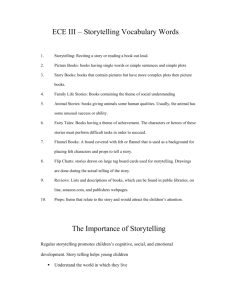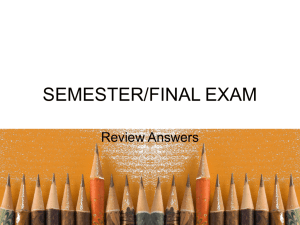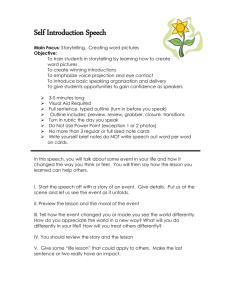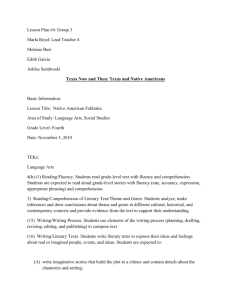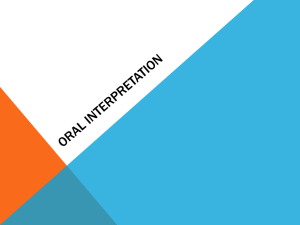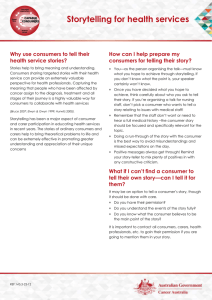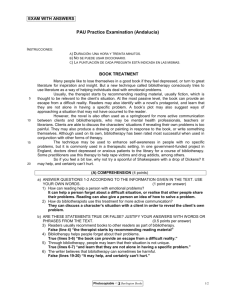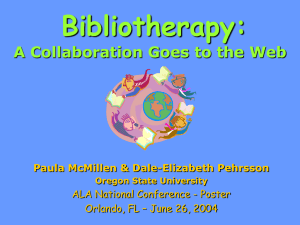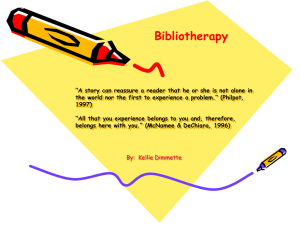Online Companion: Early Education Curriculum: A Child`s
advertisement
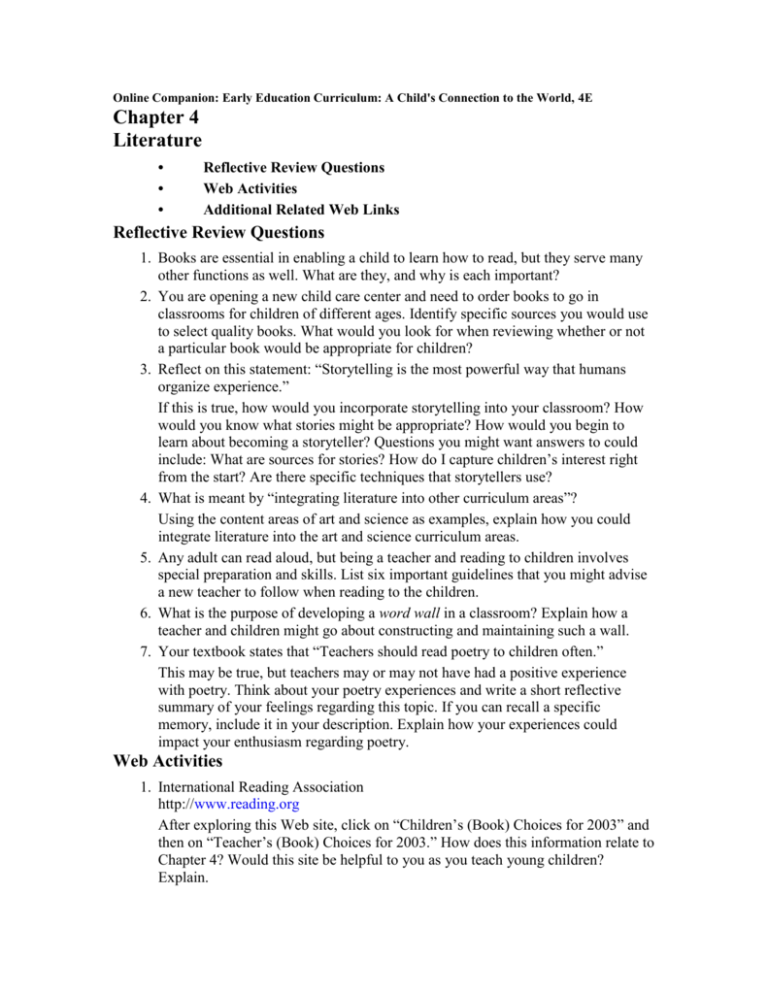
Online Companion: Early Education Curriculum: A Child's Connection to the World, 4E Chapter 4 Literature • • • Reflective Review Questions Web Activities Additional Related Web Links Reflective Review Questions 1. Books are essential in enabling a child to learn how to read, but they serve many other functions as well. What are they, and why is each important? 2. You are opening a new child care center and need to order books to go in classrooms for children of different ages. Identify specific sources you would use to select quality books. What would you look for when reviewing whether or not a particular book would be appropriate for children? 3. Reflect on this statement: “Storytelling is the most powerful way that humans organize experience.” If this is true, how would you incorporate storytelling into your classroom? How would you know what stories might be appropriate? How would you begin to learn about becoming a storyteller? Questions you might want answers to could include: What are sources for stories? How do I capture children’s interest right from the start? Are there specific techniques that storytellers use? 4. What is meant by “integrating literature into other curriculum areas”? Using the content areas of art and science as examples, explain how you could integrate literature into the art and science curriculum areas. 5. Any adult can read aloud, but being a teacher and reading to children involves special preparation and skills. List six important guidelines that you might advise a new teacher to follow when reading to the children. 6. What is the purpose of developing a word wall in a classroom? Explain how a teacher and children might go about constructing and maintaining such a wall. 7. Your textbook states that “Teachers should read poetry to children often.” This may be true, but teachers may or may not have had a positive experience with poetry. Think about your poetry experiences and write a short reflective summary of your feelings regarding this topic. If you can recall a specific memory, include it in your description. Explain how your experiences could impact your enthusiasm regarding poetry. Web Activities 1. International Reading Association http://www.reading.org After exploring this Web site, click on “Children’s (Book) Choices for 2003” and then on “Teacher’s (Book) Choices for 2003.” How does this information relate to Chapter 4? Would this site be helpful to you as you teach young children? Explain. 2. Bibliotherapy is used to help young children understand difficult issues or resolve problems. After you have read the information from the two sites below, identify five difficult topics that you think might arise when working with children in your classroom. Prepare an annotated bibliography of four books on each topic to share with your classmates. Students at Oswego College have designed a Web site that includes information on books used in helping children who are victims of child abuse. http://www.angelfire.com/ny5/childabuse/index.htm (Click on “Teachers” and then scroll down and click on “Bibliotherapy”) http://falcon.jmu.edu/~ramseyil/bibliotherapy.htm This Web site is also excellent and contains a lot of information on bibliotherapy. 3. Making a flannelboard can be a fun activity. The following Web sites have suggestions on how to make a flannelboard. AOL Hometown http://hometown.aol.com (In the Search box, type in “Let’s Create a Flannelboard” and then click on “Flannel Board Basics”) Billy Bear’s Playground http://www.billybear4kids.com (Click on “Storybooks” and then scroll down and click on “Felt Storyboards”) Pratt’s Educational Resources http://www.fastq.com/~jbpratt/education/education.html (Scroll down and click on “Flannel Board Stories”) 4. Multicultural Literature As the demographics of the United States changes, teachers will need to find more information and materials to use in classrooms that reflect the diversity of the country. If you have all Caucasian children in your classroom, it is even more important to have books and materials that represent the diverse population of the country. After exploring the Web sites, create a list of age-appropriate books that you would purchase for use in your classroom. Learning Point Associates http://www.learningpt.org (In the Search box, type in “Multicultural Children’s Literature” and then click on “Multicultural Children’s Literature”) Lee and Low Books http://leeandlow.com Multicultural Children’s Literature http://www.multiculturalchildrenslit.com Multicultural Resources for Children http://falcon.jmu.edu/~ramseyil/multipub.htm (To find additional information that might be useful, you can also conduct a Web search by typing in “Gender and Culture Issues in Children’s Books.”) 5. Storytelling is an art whose popularity is challenged by the increasing use of all types of media. However, it is still a skill that teachers of young children should learn. Examine the information from the following Web sites and then decide on a story that you want to learn to tell. Be prepared to share it during class time. Child and Family Canada http://www.cfc-efc.ca (Click on “Come see our library of 1300 articles,” Choose “Learning Activities” in the Choose a Category box, and then scroll down to “Storytelling in the Preschool Classroom”) Literacy Connections http://literacyconnections.com (In the Search box, type in “Storytelling” and then Click on “Develop Children’s Language with Storytelling”) NAEYC http://www.naeyc.org (Click on “Beyond the Journal,” click on “Beyond the Journal Archives,” click on “January 2007,” and then click on “Rocking and Rolling: Supporting Infants, Toddlers, and Their Families’ Stories—Their Powerful Role in Early Language and Literacy”) Story Arts Online http://www.storyarts.org 6. Standards regarding language arts have been revised by the National Council of English Teachers. If you live in a state that has adopted language and literacy standards, you should be familiar with them. To ensure that the activities you plan align with the standards, conduct an Internet search to locate them. Print off, or save the state standards that apply to the age group you are teaching or working with. Additional Related Web Links 1. Bank Street Children’s Book Committee http://www.bankstreet.edu/bookcom 2. Best Children’s Books http://www.best-childrens-books.com (Click on “Books and Behavior” and then click on the topic you are interested in) 3. Children’s Book Council http://www.cbcbooks.org 4. Children’s Book Press http://www.childrensbookpress.org 5. Dragon Tales http://pbskids.org (Click on “Dragon Tales”) 6. Eric Carle Web Site http://www.eric-carle.com 7. Fairrosa Cyber Library of Children’s Literature http://www.fairrosa.info 8. Nursery Rhyme http:/www.smart-central.com 9. Scholastic http://teacher.scholastic.com 10. Understanding Prejudice http://www.understandingprejudice.org
